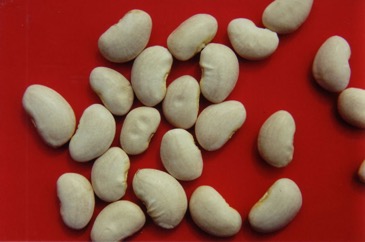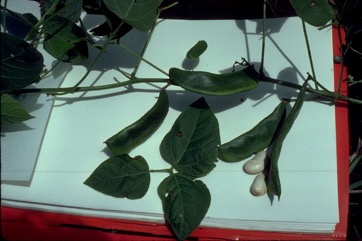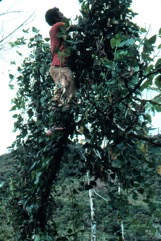Lima bean

It suits warm and subtropical areas. In the tropics it is common between 500 and 2100 m altitude but grows to the limit of cultivation (2700 m). For germination it must have a soil temperature above 15.5°C and cannot withstand frost. In very hot weather seeds often do not set. It does best in a temperature range 14-21°C. It is sensitive to a pH less than 6. It can grow in arid places. It suits hardiness zones 8-11. In Yunnan.
Also known as:
Abongband, Agwa, Akbaka, Akpatramo, Amaijalero, Apteram, Awuje, Behna, Beloi, Butter bean, Civet bean, Ckuku, Daful, Dau bach-bien, Dau-diem, Dau-ngu, Ebigaaga, Ewuje, Feijao-magalo, Frijol caballero, Htawbat-pe, Kachang china, Kachang jawa, Kachang mas, Kachang serendeng, Kal-beir-kan, Kara, Kawl-be, Kekara, Khasi kollu, Korokoco, Kpokpo, Kratok, Limski fižol, Lobia, Lobiya, Obuhindhini, Obuyindiyindi, Okuku, Onguk, Orusa, Patani, Pe-bra, Pe-byu-gyi, Pe-gya, Roway, Santagu-pe, Sem, Sieva Bean, Taipee, Tim-sin, Tua rachamat, Tunoran, Wake
Synonyms
- Phaseolus bipunctatus Jacq.
- Phaseolus inamoenus L.
- Phaseolus limensis Macfad.
- Phaseolus lunatus var. macrocarpus Benth.
- Phaseolus portoricensis Sprengel
- Phaseolus puberulus Kunth
- Phaseolus saccharatus Macfad.
- Phaseolus tonkinensis Lour.
- Phaseolus zuaresii Zuccagni
Edible Portion
- Seeds, Leaves, Pods, Vegetable, Flowers
Where does Lima bean grow?
Found in: Africa, Andes, Angola, Argentina, Asia, Australia, Bahamas, Bangladesh, Belize, Benin, Bhutan, Brazil, Cameroon, Caribbean, Central Africa, Central African Republic, CAR, Central America, Chile, China, Colombia, Comoros, Congo DR, Costa Rica, Côte d'Ivoire, Cuba, Dominican Republic, East Africa, East Timor, Ecuador, El Salvador, Equatorial Guinea, Ethiopia, Fiji, French Guiana, Gabon, Gambia, Ghana, Guatemala, Guianas, Guinea, Guinée, Guinea-Bissau, Guyana, Haiti, Hawaii, Himalayas, India, Indochina, Indonesia, Iran, Iraq, Ivory Coast, Jamaica, Japan, Kenya, Laos, Liberia, Madagascar, Malawi, Malaysia, Maldives, Mali, Marianas, Mauritius, Mexico, Mozambique, Myanmar, Nepal, Niger, Nigeria, North America, Northeastern India, Pacific, Pakistan, Panama, Papua New Guinea, PNG, Paraguay, Peru, Philippines, Puerto Rico, Reunion, Rwanda, Sao Tome and Principe, SE Asia, Seychelles, Senegal, Sierra Leone, Slovenia, Solomon Islands, South Africa, Southern Africa, South America, Sri Lanka, Sudan, Suriname, Taiwan, Tanzania, Thailand, Timor-Leste, Togo, Uganda, United States, Vanuatu, Venezuela, Vietnam, West Africa, West Indies, West Timor, Zambia, Zimbabwe
Status: It is a commercially cultivated vegetable. A quite important and common bean in many highland areas of Papua New Guinea. About 100,000 tons of dry beans are produced each year.
Growing Lima bean
Cultivation: It is grown from seed. Coloured seeds are often hard to get to grow but white seeded kinds start growing easily. Sow 3-4 seeds in a hill and put a stick 2-3 m tall in the middle. Hills should be about 1 m apart. Seeds should be 2-4 cm deep.
Edible Uses: The leaves, young pods and seeds are all eaten. The seeds are eaten fresh or after drying. They are also fried in oil. Dried beans are boiled or baked. They can be used in soups and stews. The seeds are sometimes grown as bean sprouts then cooked and eaten. CAUTION Some kinds have poison (hydrocyanic acid). This is destroyed by thorough cooking. As well the beans contain a protein inhibitor but this is destroyed by cooking.
Production: Harvesting can begin after about 100 days. Dried beans can be stored for several months. Yields of 0.12 kg of seeds per square metre have been obtained. The yield of pods can be 1 kg per square metre. The leaves, pods and flowers can be plucked from the plant.
Nutrition Info
per 100g edible portion| Edible Part | Energy (kcal) | Protein (g) | Iron (mg) | Vitamin A (ug) | Vitamin c (mg) | Zinc (mg) | % Water |
|---|---|---|---|---|---|---|---|
| Seed | 337 | 19.8 | 5.6 | Tr | 0 | - | 12 |
| Seed - young cooked | 123 | 6.8 | 2.5 | 37 | 10.1 | 0.8 | 67.2 |
| Young Seeds raw | 113 | 6.8 | 3.1 | 30 | 23.4 | 0.8 | 70.2 |
Lima bean Photos



References
Abbiw, D.K., 1990, Useful Plants of Ghana. West African uses of wild and cultivated plants. Intermediate Technology Publications and the Royal Botanic Gardens, Kew. p 31
Agea, J. G., et al 2011, Wild and Semi-wild Food Plants of Bunyoro-Kitara Kingdom of Uganda: etc. Environmental Research Journal 5(2) 74-86
Ambasta, S.P. (Ed.), 2000, The Useful Plants of India. CSIR India. p 445
Anderson, E. F., 1993, Plants and people of the Golden Triangle. Dioscorides Press. p 217
Baudoin, J.P., 2006. Phaseolus lunatus L. [Internet] Record from Protabase. Brink, M. & Belay, G. (Editors). PROTA (Plant Resources of Tropical Africa), Wageningen, Netherlands. < http://database.prota.org/search.htm>. Accessed 21 October 200919 October 2009
Beckstrom-Sternberg, Stephen M., and James A. Duke. "The Foodplant Database." http://probe.nalusda.gov:8300/cgi-bin/browse/foodplantdb.(ACEDB version 4.0 - data version July 1994)
Bianchini, F., Corbetta, F., and Pistoia, M., 1975, Fruits of the Earth. Cassell. p 34
Bodner, C. C. and Gereau, R. E., 1988, A Contribution to Bontoc Ethnobotany. Economic Botany, 43(2): 307-369
Bortolotto, I. M., et al, 2018, Lista preliminar das plantas alimenticias nativas de Mato Grosso do Sul, Brasil. Iheringia, Serie Botanica, Porto Alegre, 73 (supl.):101-116
Brown, W.H., 1920, Wild Food Plants of the Philippines. Bureau of Forestry Bulletin No. 21 Manila. p 70
Burkill, H. M., 1985, The useful plants of west tropical Africa, Vol. 3. Kew.
Castillo, R. O., 1995, Plant Genetic Resources in the Andes: Impact, Conservation, and Management. Crop Science 35:355-360
Cheifetz, A., (ed), 1999, 500 popular vegetables, herbs, fruits and nuts for Australian Gardeners. Random House p 87
Cobley, L.S. (rev. Steele, W.M.) 2nd Ed., 1976, An Introduction to the Botany of Tropical Crops. Longmans. p 89
Cundall, P., (ed.), 2004, Gardening Australia: flora: the gardener's bible. ABC Books. p 1022
Epenhuijsen C.W. van., 1974, Growing Native vegetables in Nigeria. FAO Rome, p 76
Evans, A.M., 1979, Beans, in Simmonds N.W.,(ed), Crop Plant Evolution. Longmans. London. p 168
Facciola, S., 1998, Cornucopia 2: a Source Book of Edible Plants. Kampong Publications, p 109
FAO, 1993, Valor Nutritivo Y Usis en Alimantacion humana de Algunis Cultivos Autoctonos Subexplotados de Mesoamerica. FAO, Santiago, Chile. p 96
Flora of Pakistan. www.eFloras.org
Fowler, D. G., 2007, Zambian Plants: Their Vernacular Names and Uses. Kew. p 39
Fox, F. W. & Young, M. E. N., 1982, Food from the Veld. Delta Books. p 226
French, B.R., 1986, Food Plants of Papua New Guinea, A Compendium. Asia Pacific Science Foundation p 40
French, B.R., 2010, Food Plants of Solomon Islands. A Compendium. Food Plants International Inc. p 54
Godfrey, J. et al, 2013, Harvesting, preparationand preservation of commonly consumed wild and semi-wild food plants in Bunyoro-Kitara Kingdom, Uganda. Int. J. Med. Arom. Plants. Vol.3 No.2 pp 262-282
Goode, P., 1989, Edible Plants of Uganda. FAO p 26
Goode, P., 1989, Edible Plants of Uganda. FAO p 39
Hadfield, J., 2001, The A-Z of Vegetable Gardening in South Africa. Struik p 94
Hedrick, U.P., 1919, (Ed.), Sturtevant's edible plants of the world. p 477
Henty, E.E., 1980, Harmful Plants in Papua New Guinea. Botany Bulletin No 12. Division Botany, Lae, Papua New Guinea. p 94, Pl. 32
Hermandez Bermejo, J.E., and Leon, J. (Eds.), 1994, Neglected Crops. 1492 from a different perspective. FAO Plant Production and Protection Series No 26. FAO, Rome. p 54
http://www.botanic-gardens-ljubljana.com/en/plants
Hu, Shiu-ying, 2005, Food Plants of China. The Chinese University Press. p 480 (As Phaseolus limensis)
ILDIS Legumes of the World http:www:ildis.org/Legume/Web
Jardin, C., 1970, List of Foods Used In Africa, FAO Nutrition Information Document Series No 2.p 28
Kays, S. J., and Dias, J. C. S., 1995, Common Names of Commercially Cultivated Vegetables of the World in 15 languages. Economic Botany, Vol. 49, No. 2, pp. 115-152
Kiple, K.F. & Ornelas, K.C., (eds), 2000, The Cambridge World History of Food. CUP p 1729
Kuo, W. H. J., (Ed.) Taiwan's Ethnobotanical Database (1900-2000), http://tk.agron.ntu.edu.tw/ethnobot/DB1.htm
Latham, P., 2004, Useful Plants of Bas-Congo province. Salvation Army & DFID p 221
Lazarides, M. & Hince, B., 1993, Handbook of Economic Plants of Australia, CSIRO. p 187
Lembogi Biologi Nasional, 1980, Sayur-sayuran. Balai Pustaka, Jakarta. p 72
Macmillan, H.F. (Revised Barlow, H.S., et al) 1991, Tropical Planting and Gardening. Sixth edition. Malayan Nature Society. Kuala Lumpur. p 328
Martin, F.W. & Ruberte, R.M., 1979, Edible Leaves of the Tropics. Antillian College Press, Mayaguez, Puerto Rico. p 45, 200
Medhi, P. & Borthakur, S. K., 2012, Phytoresources from North Cachur Hills of Assam -3: Edible plants sold at Hflong market. Indian Journal or Natural Products and Resources. 3(1) pp 84-109
Moerman, D. F., 2010, Native American Ethnobotany. Timber Press. p 390
Molares, S. & Ladio, A., 2012, The Usefulness of Edible and Medicinal Fabaceae in Argentine and Chilean Patagonia: Environmental Availability and Other Sources of Supply. Evidence-Based Complementary and Alternative Medicine. Volume 2012, Article ID 901918, 12 pages, Hindawi Publishing Corporation.
Nyadanu, D., et al, 2015, Agro-biodiversity and challenges of on-farm conservation: the case of plant genetic resources of neglected and underutilized crop species in Ghana. Genet. Resourc. Crop Evol. 62(7):
Ochse, J.J. et al, 1931, Vegetables of the Dutch East Indies. Asher reprint. p 409
Omawale, 1973, Guyana's edible plants. Guyana University, Georgetown p 86
Owen, S., 1993, Indonesian Food and Cookery, INDIRA reprints. p 64
Peekel, P.G., 1984, (Translation E.E.Henty), Flora of the Bismarck Archipelago for Naturalists, Division of Botany, Lae, PNG. p 257, 254
Pham-Hoang Ho, 1999, An Illustrated Flora of Vietnam. Nha Xuat Ban Tre. p 963
Plants for a Future database, The Field, Penpol, Lostwithiel, Cornwall, PL22 0NG, UK. http://www.scs.leeds.ac.uk/pfaf/
Plants of Haiti Smithsonian Institute http://botany.si.edu/antilles/West Indies
PROSEA
Purseglove, J.W., 1968, Tropical Crops Dicotyledons, Longmans. p 296
Royal Botanic Gardens, Kew (1999). Survey of Economic Plants for Arid and Semi-Arid Lands (SEPASAL) database. Published on the Internet; http://www.rbgkew.org.uk/ceb/sepasal/internet [Accessed 29th April 2011]
Rubaihayo, E. B., Conservation and use of traditional vegetables in Uganda. Bioversity International.
Sharma, B.B., 2005, Growing fruits and vegetables. Publications Division. Ministry of Information and broadcasting. India. p 149
Small, E., 2009, Top 100 Food Plants. The world's most important culinary crops. NRC Research Press. p 318
Solomon, C., 2001, Encyclopedia of Asian Food. New Holland. p 211
Sp. pl. 2:724. 1753
Staples, G.W. and Herbst, D.R., 2005, A tropical Garden Flora. Bishop Museum Press, Honolulu, Hawaii. p 320
Sukenti, K., et al, 2016, Ethnobotanical study on local cuisine of the Sasak tribe in Lombok Island, Indonesia. Journal of Ethnic Foods. 3 (2016) 189-200 p 198
Tapia, M. E., The role of under-utilised plant species with regard to increased food security and improved health of poor poeople, in mountain regions. IIAP-PNUD/Peru
Terra, G.J.A., 1973, Tropical Vegetables. Communication 54e Royal Tropical Institute, Amsterdam, p 65
Tindall, H.D., 1983, Vegetables in the Tropics, Macmillan p 277
Tronickova, E. & Krejcova, Z., 1987, Ortaggi, Instituto Geografico de Agostini, Cecoslovacchia. p 128
USDA, ARS, National Genetic Resources Program. Germplasm Resources Information Network - (GRIN). [Online Database] National Germplasm Resources Laboratory, Beltsville, Maryland. Available: www.ars-grin.gov/cgi-bin/npgs/html/econ.pl (10 April 2000)
van Wyk, B., 2005, Food Plants of the World. An illustrated guide. Timber press. p 289
Verdcourt, B., 1979, Manual of New Guinea Legumes. Botany Bulletin No 11, Division of Botany, Lae, Papua New Guinea. p 513
Vickery, M.L. and Vickery, B., 1979, Plant Products of Tropical Africa, Macmillan. p 22
Williamson, J., 2005, Useful Plants of Malawi. 3rd. Edition. Mdadzi Book Trust. p 195
Woodward, P., 2000, Asian Herbs and Vegetables. Hyland House. p 110
Zhang, L., et al, 2016, Ethnobotanical study of traditional edible plants used by the Naxi people during droughts. Journal of Ethnobiology and Ethnomedicine. 12:39